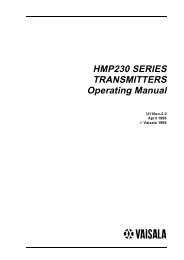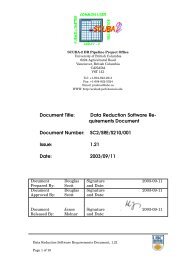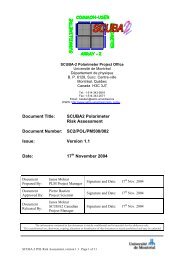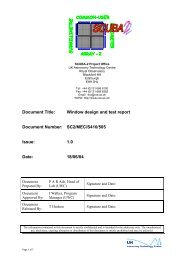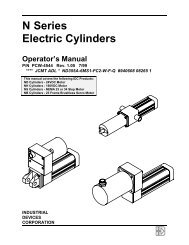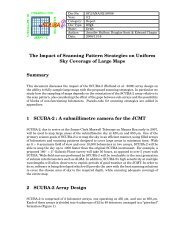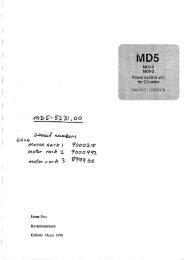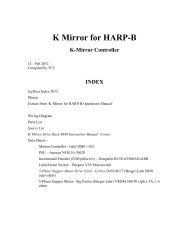Requirements Document Template for the Polarimeter - JACH
Requirements Document Template for the Polarimeter - JACH
Requirements Document Template for the Polarimeter - JACH
Create successful ePaper yourself
Turn your PDF publications into a flip-book with our unique Google optimized e-Paper software.
Figure 3. Schematic of a Mach-Zehnder FTS.<br />
The design of <strong>the</strong> SCUBA-2 FTS is complicated by <strong>the</strong> fact that we do not have access to<br />
a small diameter collimated beam in <strong>the</strong> SCUBA-2 feed optics. In order to construct an<br />
imaging FTS <strong>for</strong> <strong>the</strong> SCUBA-2 system that uses at least one quarter of <strong>the</strong> full array in<br />
each band, <strong>the</strong> following key components are required:<br />
1) Beam splitters: Two intensity beam splitters are required that have equal<br />
transmission and reflection in both <strong>the</strong> 450 and 850 bands. The target is to image<br />
one quarter of <strong>the</strong> full SCUBA-2 beam through <strong>the</strong> FTS, <strong>the</strong>re<strong>for</strong>e <strong>the</strong> beam<br />
splitters will need to be large enough to accommodate one quarter of <strong>the</strong> full<br />
SCUBA-2 beam at <strong>the</strong> outside of <strong>the</strong> elevation bearing after it has been suitably<br />
collimated (~300 mm). Cardiff should be able to provide 300 mm beamsplitters,<br />
although none have yet been manufactured of this size. Manufacture of larger<br />
diameters may be possible with some retooling of <strong>the</strong> Cardiff shop.<br />
2) Blackbody: A large aperture variable temperature cryogenic blackbody source<br />
will be required <strong>for</strong> calibration, reducing <strong>the</strong> power loading on <strong>the</strong> bolometers,<br />
and possibly <strong>for</strong> canceling out <strong>the</strong> large signal swings as <strong>the</strong> interferometer scans<br />
through <strong>the</strong> zero path difference (ZPD) position.<br />
3) Pickoff mirrors: Since <strong>the</strong> beam is not collimated between mirrors C3 and N1,<br />
and <strong>the</strong>re is not enough space to place an FTS directly in <strong>the</strong> beam, pickoff and<br />
return mirrors will be required to collimate <strong>the</strong> desired portion of <strong>the</strong> beam, pass it<br />
through <strong>the</strong> spectrometer, and return it to mirror N1 in its original state. These<br />
mirrors will need to be on a motorized stage so that <strong>the</strong>y can be removed from <strong>the</strong><br />
beam when <strong>the</strong> FTS is not in use.<br />
4) Linear Stage: The moving rooftop mirrors will need to be large enough to<br />
accommodate <strong>the</strong> desired 300 mm beam, and will likely be quite massive. (If <strong>the</strong>y<br />
are made from aluminum and not lightweighted, <strong>the</strong>n <strong>the</strong> mass could be as large<br />
as 70 kg.) The linear stage must have a suitable load capacity, be powerful enough<br />
to accelerate <strong>the</strong> mirrors (~1 m/sec 2 ), and have a positional accuracy of 1 um or<br />
better. The required acceleration is not yet known, as possible FTS observing<br />
modes are still being investigated.<br />
SCUBA-2 FTS <strong>Requirements</strong>, version 1.0<br />
Page 4 of 8




